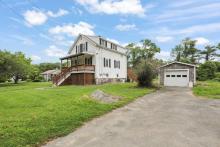What was it like at Tobey Hospital during the blizzard?
When the Blizzard of 2013 blew in last month, Eileen Sugrue-McElearney, vice-president for Oncology Services at Southcoast Health System, found herself in charge.
"I happened to have the honor of being the administrator on-call of Southcoast during the storm," Sugrue-McElearney recalled with a chuckle. "When we have an event like this, we have sort of a local command center and a supportive command center at the other two hospitals" — that is, Charlton Memorial Hospital in Fall River and St. Luke's in New Bedford.
With 96% of Wareham without power at the worst part of the weekend, Tobey Hospital needed that support network.
It was an unusual situation. Weather is generally much warmer when a hurricane knocks out power. In the blizzard, people were not only in need of electricity for medical reasons… they were also very, very cold.
"As we came to late in the day on Saturday [Feb. 9] and into Saturday evening, we realized that the [Wareham] community was feeling the impact of being without power," said Sugrue-McElearney. "We began to sort of rally around what that might mean in terms of evening admissions of patients. … If they came to us, how might [employees] manage them?"
Tobey Hospital began keeping staff at the hospital beginning on Friday, Feb. 8, when the storm ramped up.
Residents began arriving at the hospital in droves.
"The on-site clinical management team made decisions about staffing needs and retained staff so that we could adequately care for these patients, and the staff did so willingly," Sugrue-McElearney noted. "The next morning, staff stayed on as needed or went home, slept for a short time, and returned."
Tobey was particularly hard-hit on Sunday.
"We had a lot of patients on Sunday morning. Tobey usually runs an average of about 60 patients in the house, and we were up above 90," Sugrue-McElearney explained. Everybody — from clinical staff to food-service workers "stepped up to handle what is a normally quiet Sunday."
The patients' ailments varied throughout the weekend. Some needed to ensure that they had electricity for their medical devices. Some came in with weather-related health issues.
"A lot of patients [came in] with hypothermia," Sugrue-McElearney said, noting that for the elderly and frail, "a drop in temperature that a 50-year-old or 30-year-old could weather, an 80-year-old can't."
Arrangements were made for staff to eat and sleep at the hospital, because it wasn't clear when they might be able to leave.
"The biggest challenge was taking care of patients and staff appropriately, making arrangements for patients to be in the right place to be cared for, staff to sleep, everyone to eat," said Sugrue-McElearney. "We were making beds around the clock."
Fortunately, with a little help from the other two hospitals, Tobey didn't run out of much-needed supplies.
"We had staff running to Tobey to bring food over from St. Luke's, we had oxygen tanks that were brought over from St. Luke's. That's what's nice about being part of a system," Sugrue-McElearney explained. " You have your sister facilities to borrow from."
Sugrue-McElearney credits the blizzard with offering a learning opportunity.
"We sort of became more knowledgeable about what it means to sleep over staff," she said.
In total, approximately 60 staff stayed at Tobey overnight, as well as approximately 150 at Charleton and 150 at St. Luke's.
"[We were] making beds, flipping linens, feeding staff… and keeping everyone in good spirits," Sugrue-McElearney said. "It really gave our staff an opportunity to shine."












